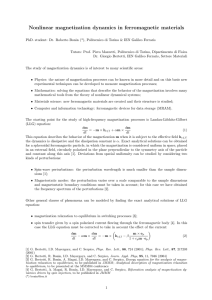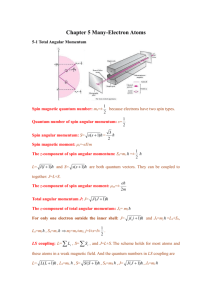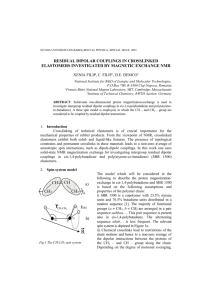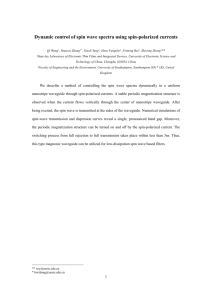Local doc file
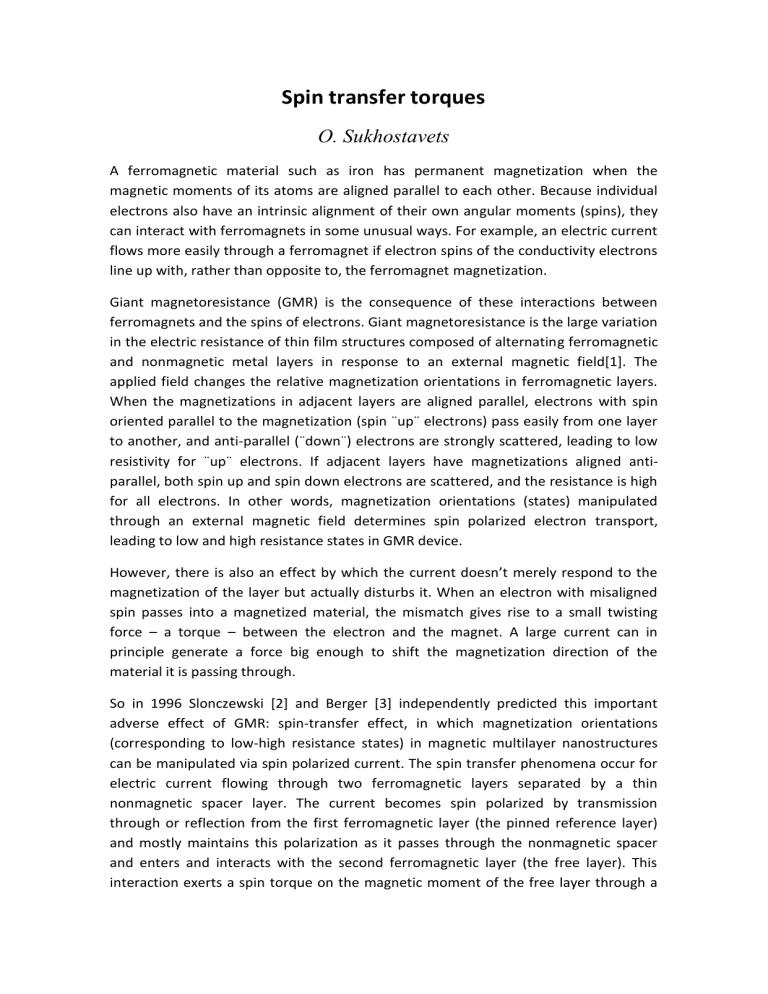
Spin transfer torques
O. Sukhostavets
A ferromagnetic material such as iron has permanent magnetization when the magnetic moments of its atoms are aligned parallel to each other. Because individual electrons also have an intrinsic alignment of their own angular moments (spins), they can interact with ferromagnets in some unusual ways. For example, an electric current flows more easily through a ferromagnet if electron spins of the conductivity electrons line up with, rather than opposite to, the ferromagnet magnetization.
Giant magnetoresistance (GMR) is the consequence of these interactions between ferromagnets and the spins of electrons. Giant magnetoresistance is the large variation in the electric resistance of thin film structures composed of alternating ferromagnetic and nonmagnetic metal layers in response to an external magnetic field[1]. The applied field changes the relative magnetization orientations in ferromagnetic layers.
When the magnetizations in adjacent layers are aligned parallel, electrons with spin oriented parallel to the magnetization (spin ¨up¨ electrons) pass easily from one layer to another, and anti-parallel (¨down¨) electrons are strongly scattered, leading to low resistivity for ¨up¨ electrons. If adjacent layers have magnetizations aligned antiparallel, both spin up and spin down electrons are scattered, and the resistance is high for all electrons. In other words, magnetization orientations (states) manipulated through an external magnetic field determines spin polarized electron transport, leading to low and high resistance states in GMR device.
However, there is also an effect by which the current doesn’t merely respond to the magnetization of the layer but actually disturbs it. When an electron with misaligned spin passes into a magnetized material, the mismatch gives rise to a small twisting force – a torque – between the electron and the magnet. A large current can in principle generate a force big enough to shift the magnetization direction of the material it is passing through.
So in 1996 Slonczewski [2] and Berger [3] independently predicted this important adverse effect of GMR: spin-transfer effect, in which magnetization orientations
(corresponding to low-high resistance states) in magnetic multilayer nanostructures can be manipulated via spin polarized current. The spin transfer phenomena occur for electric current flowing through two ferromagnetic layers separated by a thin nonmagnetic spacer layer. The current becomes spin polarized by transmission through or reflection from the first ferromagnetic layer (the pinned reference layer) and mostly maintains this polarization as it passes through the nonmagnetic spacer and enters and interacts with the second ferromagnetic layer (the free layer). This interaction exerts a spin torque on the magnetic moment of the free layer through a
transfer of angular momentum from the polarized current to the magnetization of free layer. This spin torque can oppose the intrinsic damping of the free layer causing the magnetization precession (exciting, for instance, spin waves) and/or reverse the direction of the magnetization with sufficient current strength. Spin-transfer can have important implications on electronic device applications since it provides local means of the material magnetization manipulation rather than using the long-range Oersted field generated by a remote current.
1) Why spin-transfer torque is relevant to nanoscience?
This effect is relevant to nanoscience because it deals with the intrinsic angular momentum of electron – spin. So, the interactions between the electrons in spin polarized current and electrons in ferromagnet occur on nanoscale range as the interaction between electrons due to their spins, but the consequence of these interactions can be seen on macroscale, because the macroscopic magnetization of ferromagnet has changed.
2) Why do I think that the system is added to nanoscience?
Spin-transfer torques are interfacial, so the free layer is kept thin, usually 3-6 nm thick, because the current necessary to move the magnetization from its ground state is proportional to this thickness. Typically, the fixed layer is much thicker than the free layer so it responds less strongly to the current density necessary to move the magnetization.
The devices based on the spin-transfer torque effect can be subdivided into nanopillar devices and point contact devices. A nanopillar is designed such that the free, spacer and fixed pinned layers, constructed with desired dimensions, are sandwiched between conducting materials wider than the layers. The current is then easily applied to the larger layers. In the point contact geometry, the current is directed only through a small contact area that was created using lithography techniques. The spacer is thin enough so no significant diffusion of the electrons will occur, and therefore the current will be directed only to the area directly under the point contact.
It is necessary to use one of these methods to direct the current to a small area. Spin transfer torque is only seen in high current density structures, on the order of
10 12 A/m 2 . However, when the current is only passing through an area with the crosssection of 100 nm or less, this high current density corresponds just to few milliamps, a reasonable number. So, this is another reason, why this effect is added to nanoscience, because it can be observed and used due to the nanosizes of device.
3) What are the relevant questions need to be answered?
The potential application of this effect can be Spin transfer torque based magnetic random access memory (MRAM) [4] and current tunable high frequency oscillators for microwave power generation [5].
Exploitation of spin-transfer torque is being studied for the development of nonvolatile magnetic devices based on current control. Devices utilizing spin transfer torque can be faster, smaller, and require less power to switch.
In the reversal of magnetization by Spin Transfer Torque, the density currents involved are very high. It would be, for applications, very nice to find a way to reduce them. In the case of vortex nanooscillators, the signal should be increased.
4) Is quantum confinement possible in the system?
Quantum confinement of the spin-polarized electrons is possible in the system.
Moreover, it is responsible for the STT effect. The SST occurs due to reflection or transmition of the electrons through interfaces between the ferromagnetic and nonmagnetic media (layers). So, geometrical confinement in such STT devices is of principal importance and influences essentially quantum states of the spin-polarized electrons.
REFERENCES
[1] M.N.Baibich et al., Phys.Rev.Lett.61, 2472 (1988)
[2] J.C.Slonczewski, J.Magn.Magn.Mater.159, L1 (1996)
[3] L.Berger, Phys.Rev.B 54,9353 (1996)
[4] Yiming Huai et al., Appl.Phys.Lett.84, 3118 (2004)
[5] S.I.Kiselev et al., Nature 425, 380 (2003); S.I.Kiselev et al.,Phys.Rev.Lett 93, 036601
(2004)


